Organisational Behaviour Assignment Sample : 1Spatial plc
VerifiedAdded on 2021/01/01
|18
|5669
|85
AI Summary
Contribute Materials
Your contribution can guide someone’s learning journey. Share your
documents today.
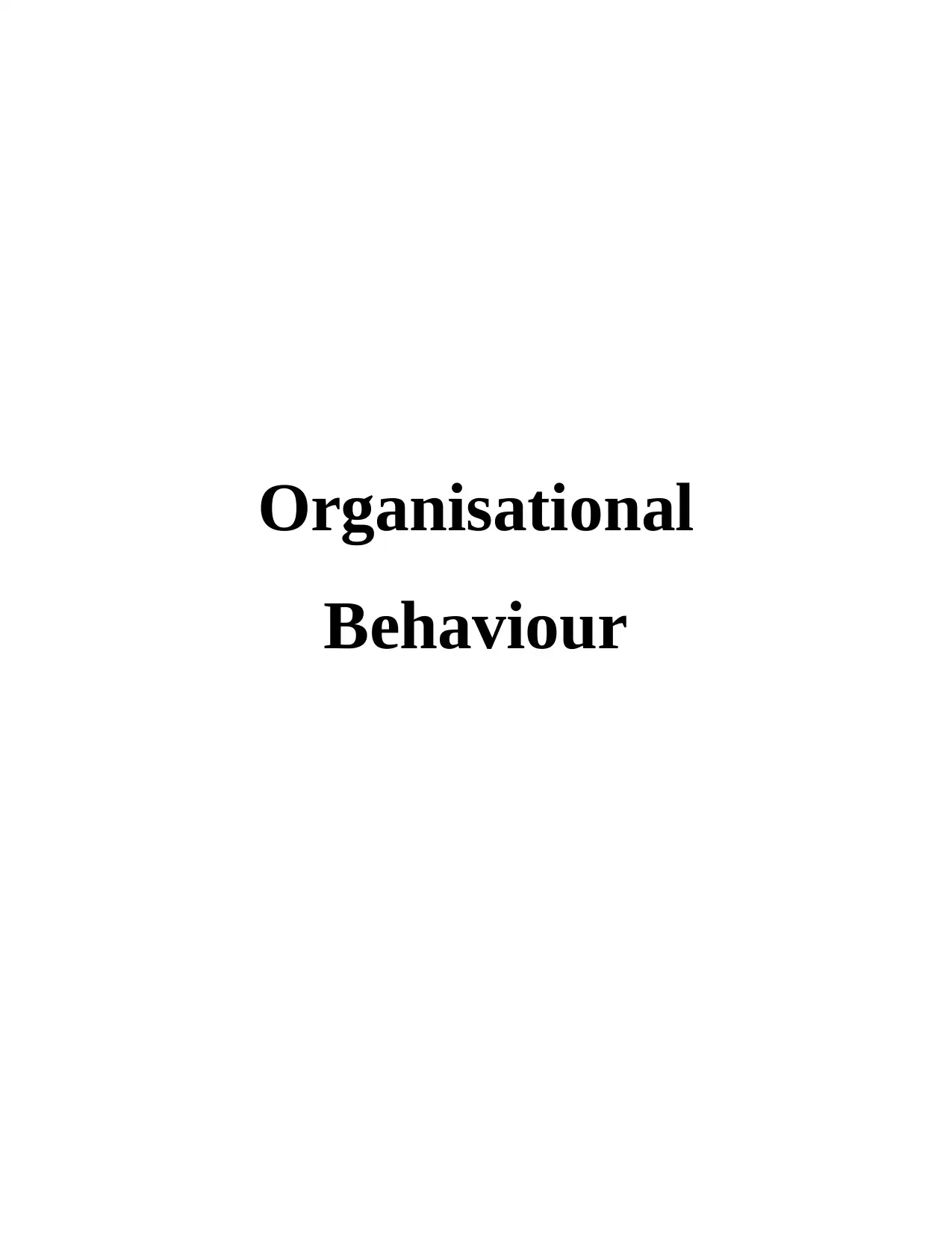
Organisational
Behaviour
Behaviour
Secure Best Marks with AI Grader
Need help grading? Try our AI Grader for instant feedback on your assignments.

Table of Contents
INTROUCTION..............................................................................................................................3
TASK 1............................................................................................................................................3
P1 Analyse how an organisation’s culture, politics and power influence individual and team
behaviour and performance. .......................................................................................................3
TASK 2............................................................................................................................................6
P2 Evaluate how content and process theories of motivation and motivational techniques
enable effective achievement of goals in an organisational context...........................................6
TASK 3 ...........................................................................................................................................8
P3 Explain what makes an effective team as opposed to an ineffective team............................8
TASK 4..........................................................................................................................................10
P4 Apply concepts and philosophies of organisational behaviour within an organisational
context and a given business situation. ....................................................................................10
CONCLUSION .............................................................................................................................12
REFERENCES..............................................................................................................................12
.......................................................................................................................................................13
INTROUCTION..............................................................................................................................3
TASK 1............................................................................................................................................3
P1 Analyse how an organisation’s culture, politics and power influence individual and team
behaviour and performance. .......................................................................................................3
TASK 2............................................................................................................................................6
P2 Evaluate how content and process theories of motivation and motivational techniques
enable effective achievement of goals in an organisational context...........................................6
TASK 3 ...........................................................................................................................................8
P3 Explain what makes an effective team as opposed to an ineffective team............................8
TASK 4..........................................................................................................................................10
P4 Apply concepts and philosophies of organisational behaviour within an organisational
context and a given business situation. ....................................................................................10
CONCLUSION .............................................................................................................................12
REFERENCES..............................................................................................................................12
.......................................................................................................................................................13

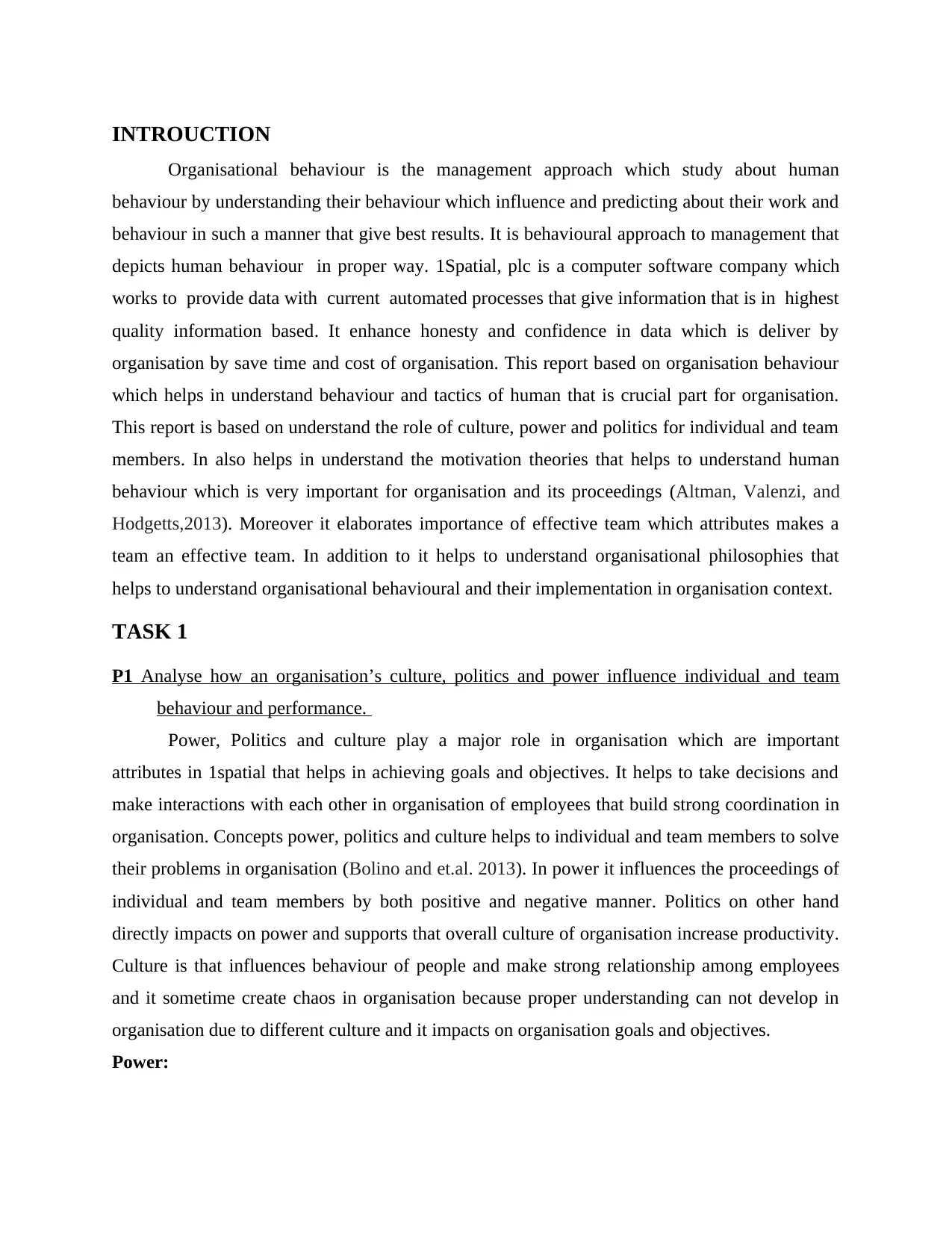
INTROUCTION
Organisational behaviour is the management approach which study about human
behaviour by understanding their behaviour which influence and predicting about their work and
behaviour in such a manner that give best results. It is behavioural approach to management that
depicts human behaviour in proper way. 1Spatial, plc is a computer software company which
works to provide data with current automated processes that give information that is in highest
quality information based. It enhance honesty and confidence in data which is deliver by
organisation by save time and cost of organisation. This report based on organisation behaviour
which helps in understand behaviour and tactics of human that is crucial part for organisation.
This report is based on understand the role of culture, power and politics for individual and team
members. In also helps in understand the motivation theories that helps to understand human
behaviour which is very important for organisation and its proceedings (Altman, Valenzi, and
Hodgetts,2013). Moreover it elaborates importance of effective team which attributes makes a
team an effective team. In addition to it helps to understand organisational philosophies that
helps to understand organisational behavioural and their implementation in organisation context.
TASK 1
P1 Analyse how an organisation’s culture, politics and power influence individual and team
behaviour and performance.
Power, Politics and culture play a major role in organisation which are important
attributes in 1spatial that helps in achieving goals and objectives. It helps to take decisions and
make interactions with each other in organisation of employees that build strong coordination in
organisation. Concepts power, politics and culture helps to individual and team members to solve
their problems in organisation (Bolino and et.al. 2013). In power it influences the proceedings of
individual and team members by both positive and negative manner. Politics on other hand
directly impacts on power and supports that overall culture of organisation increase productivity.
Culture is that influences behaviour of people and make strong relationship among employees
and it sometime create chaos in organisation because proper understanding can not develop in
organisation due to different culture and it impacts on organisation goals and objectives.
Power:
Organisational behaviour is the management approach which study about human
behaviour by understanding their behaviour which influence and predicting about their work and
behaviour in such a manner that give best results. It is behavioural approach to management that
depicts human behaviour in proper way. 1Spatial, plc is a computer software company which
works to provide data with current automated processes that give information that is in highest
quality information based. It enhance honesty and confidence in data which is deliver by
organisation by save time and cost of organisation. This report based on organisation behaviour
which helps in understand behaviour and tactics of human that is crucial part for organisation.
This report is based on understand the role of culture, power and politics for individual and team
members. In also helps in understand the motivation theories that helps to understand human
behaviour which is very important for organisation and its proceedings (Altman, Valenzi, and
Hodgetts,2013). Moreover it elaborates importance of effective team which attributes makes a
team an effective team. In addition to it helps to understand organisational philosophies that
helps to understand organisational behavioural and their implementation in organisation context.
TASK 1
P1 Analyse how an organisation’s culture, politics and power influence individual and team
behaviour and performance.
Power, Politics and culture play a major role in organisation which are important
attributes in 1spatial that helps in achieving goals and objectives. It helps to take decisions and
make interactions with each other in organisation of employees that build strong coordination in
organisation. Concepts power, politics and culture helps to individual and team members to solve
their problems in organisation (Bolino and et.al. 2013). In power it influences the proceedings of
individual and team members by both positive and negative manner. Politics on other hand
directly impacts on power and supports that overall culture of organisation increase productivity.
Culture is that influences behaviour of people and make strong relationship among employees
and it sometime create chaos in organisation because proper understanding can not develop in
organisation due to different culture and it impacts on organisation goals and objectives.
Power:
Secure Best Marks with AI Grader
Need help grading? Try our AI Grader for instant feedback on your assignments.

In view of Robbins power work as a capacity to influences the behaviour of individual
that influence behaviour of others. With help of power numerous conflicts and troubles should be
resolved. In power more than one person interact with one another by influencing behaviour of
each other. The nature of power is that it never static or absolute. It creates relationship that
changes according to situation or circumstances (Bolman and Deal, 2017). Same in happen in
that case when managers give instructions and influences behaviour of their subordinates but at
same time they not influences behaviour of employees on other department. Power relationship
is sole medium which helps to coordinate within organisation to achieve their goals and
objectives. But when departments and positions changes according to it powers also changes.
Sources of power:
(Source: Sources of power 2018.)
Reward Power: This is best method of motivation for employees in organisation by
distribute rewards so that they can give their best to organisation. Instances of reward
power consist of salary increases, bonuses, promotions and appraisals etc.. Also praise
also use as reward power which plays a crucial role for some time.
Coercive power( punishment power): This power is based upon fear and terror. It is
way to create not pleasant consequences in organisation. In that includes powers such as
threats and punishments (Borkowski, 2015). Some instances of coercive power is verbal
abusiveness, lack in support, and disciplinary actions etc. are behaviours that represent
negative rewards in organisation.
Referent power: In referent power managers influence behaviour of others by charisma,
attraction and influence behaviour of others through liking and respecting others ( Housto
that influence behaviour of others. With help of power numerous conflicts and troubles should be
resolved. In power more than one person interact with one another by influencing behaviour of
each other. The nature of power is that it never static or absolute. It creates relationship that
changes according to situation or circumstances (Bolman and Deal, 2017). Same in happen in
that case when managers give instructions and influences behaviour of their subordinates but at
same time they not influences behaviour of employees on other department. Power relationship
is sole medium which helps to coordinate within organisation to achieve their goals and
objectives. But when departments and positions changes according to it powers also changes.
Sources of power:
(Source: Sources of power 2018.)
Reward Power: This is best method of motivation for employees in organisation by
distribute rewards so that they can give their best to organisation. Instances of reward
power consist of salary increases, bonuses, promotions and appraisals etc.. Also praise
also use as reward power which plays a crucial role for some time.
Coercive power( punishment power): This power is based upon fear and terror. It is
way to create not pleasant consequences in organisation. In that includes powers such as
threats and punishments (Borkowski, 2015). Some instances of coercive power is verbal
abusiveness, lack in support, and disciplinary actions etc. are behaviours that represent
negative rewards in organisation.
Referent power: In referent power managers influence behaviour of others by charisma,
attraction and influence behaviour of others through liking and respecting others ( Housto
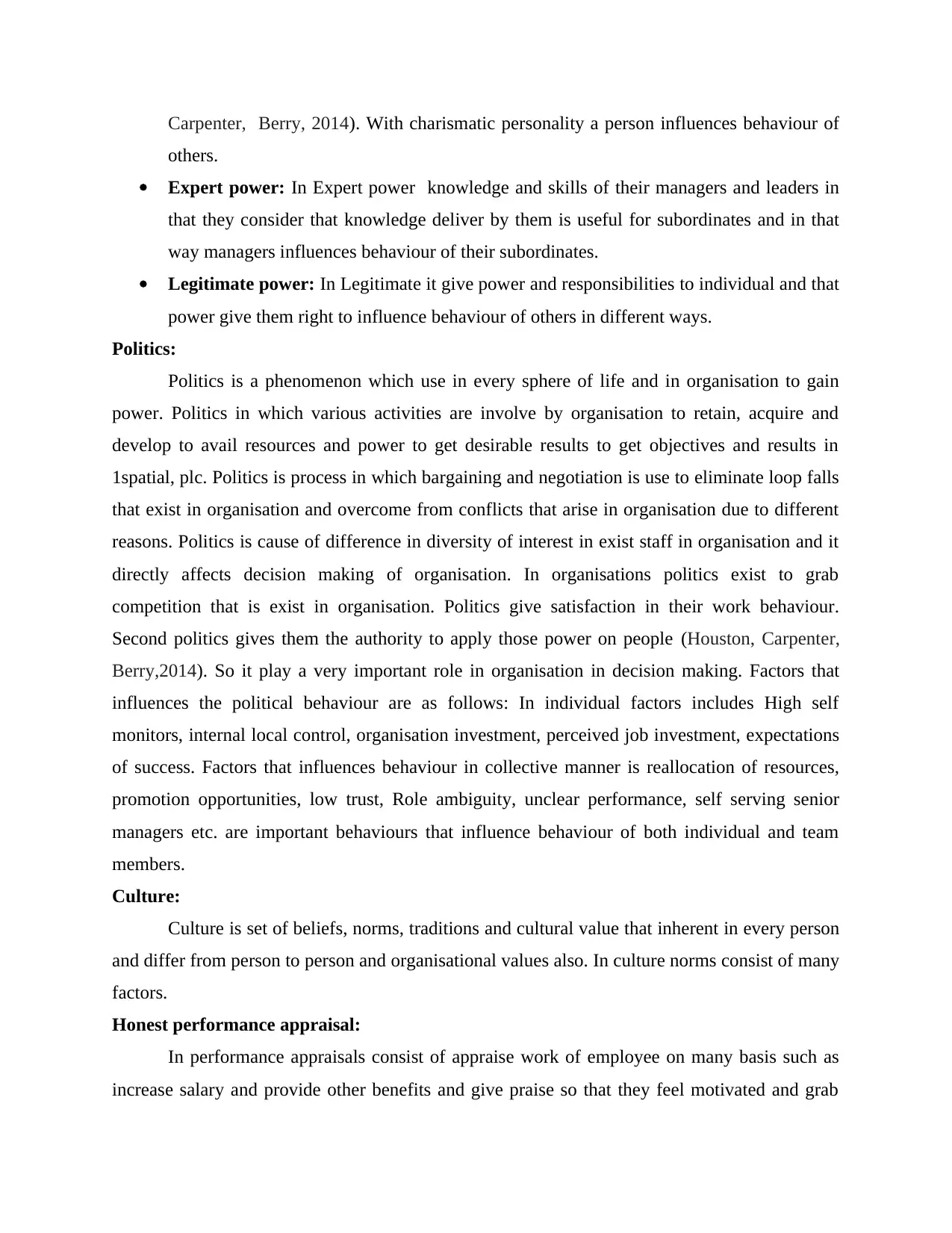
Carpenter, Berry, 2014). With charismatic personality a person influences behaviour of
others.
Expert power: In Expert power knowledge and skills of their managers and leaders in
that they consider that knowledge deliver by them is useful for subordinates and in that
way managers influences behaviour of their subordinates.
Legitimate power: In Legitimate it give power and responsibilities to individual and that
power give them right to influence behaviour of others in different ways.
Politics:
Politics is a phenomenon which use in every sphere of life and in organisation to gain
power. Politics in which various activities are involve by organisation to retain, acquire and
develop to avail resources and power to get desirable results to get objectives and results in
1spatial, plc. Politics is process in which bargaining and negotiation is use to eliminate loop falls
that exist in organisation and overcome from conflicts that arise in organisation due to different
reasons. Politics is cause of difference in diversity of interest in exist staff in organisation and it
directly affects decision making of organisation. In organisations politics exist to grab
competition that is exist in organisation. Politics give satisfaction in their work behaviour.
Second politics gives them the authority to apply those power on people (Houston, Carpenter,
Berry,2014). So it play a very important role in organisation in decision making. Factors that
influences the political behaviour are as follows: In individual factors includes High self
monitors, internal local control, organisation investment, perceived job investment, expectations
of success. Factors that influences behaviour in collective manner is reallocation of resources,
promotion opportunities, low trust, Role ambiguity, unclear performance, self serving senior
managers etc. are important behaviours that influence behaviour of both individual and team
members.
Culture:
Culture is set of beliefs, norms, traditions and cultural value that inherent in every person
and differ from person to person and organisational values also. In culture norms consist of many
factors.
Honest performance appraisal:
In performance appraisals consist of appraise work of employee on many basis such as
increase salary and provide other benefits and give praise so that they feel motivated and grab
others.
Expert power: In Expert power knowledge and skills of their managers and leaders in
that they consider that knowledge deliver by them is useful for subordinates and in that
way managers influences behaviour of their subordinates.
Legitimate power: In Legitimate it give power and responsibilities to individual and that
power give them right to influence behaviour of others in different ways.
Politics:
Politics is a phenomenon which use in every sphere of life and in organisation to gain
power. Politics in which various activities are involve by organisation to retain, acquire and
develop to avail resources and power to get desirable results to get objectives and results in
1spatial, plc. Politics is process in which bargaining and negotiation is use to eliminate loop falls
that exist in organisation and overcome from conflicts that arise in organisation due to different
reasons. Politics is cause of difference in diversity of interest in exist staff in organisation and it
directly affects decision making of organisation. In organisations politics exist to grab
competition that is exist in organisation. Politics give satisfaction in their work behaviour.
Second politics gives them the authority to apply those power on people (Houston, Carpenter,
Berry,2014). So it play a very important role in organisation in decision making. Factors that
influences the political behaviour are as follows: In individual factors includes High self
monitors, internal local control, organisation investment, perceived job investment, expectations
of success. Factors that influences behaviour in collective manner is reallocation of resources,
promotion opportunities, low trust, Role ambiguity, unclear performance, self serving senior
managers etc. are important behaviours that influence behaviour of both individual and team
members.
Culture:
Culture is set of beliefs, norms, traditions and cultural value that inherent in every person
and differ from person to person and organisational values also. In culture norms consist of many
factors.
Honest performance appraisal:
In performance appraisals consist of appraise work of employee on many basis such as
increase salary and provide other benefits and give praise so that they feel motivated and grab
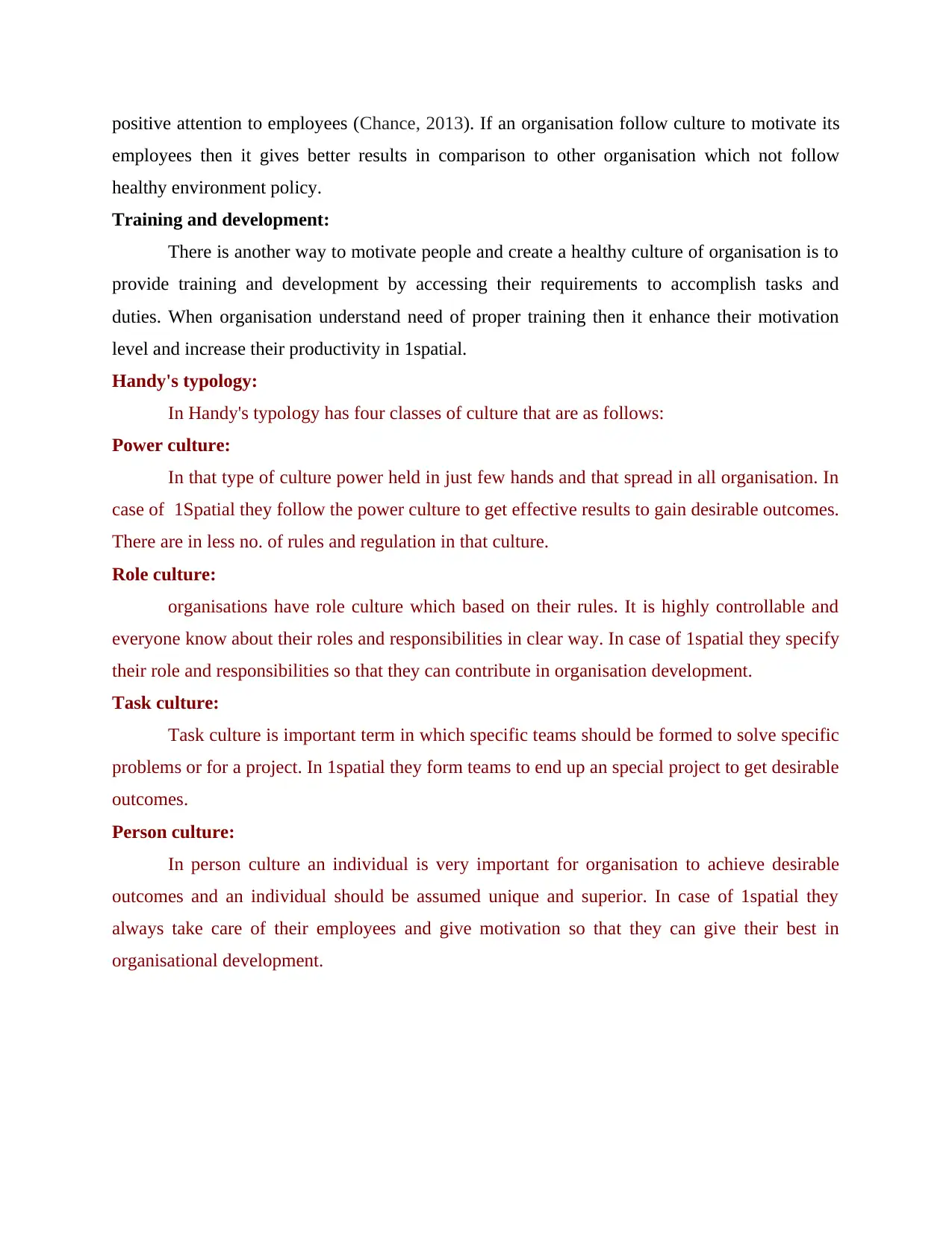
positive attention to employees (Chance, 2013). If an organisation follow culture to motivate its
employees then it gives better results in comparison to other organisation which not follow
healthy environment policy.
Training and development:
There is another way to motivate people and create a healthy culture of organisation is to
provide training and development by accessing their requirements to accomplish tasks and
duties. When organisation understand need of proper training then it enhance their motivation
level and increase their productivity in 1spatial.
Handy's typology:
In Handy's typology has four classes of culture that are as follows:
Power culture:
In that type of culture power held in just few hands and that spread in all organisation. In
case of 1Spatial they follow the power culture to get effective results to gain desirable outcomes.
There are in less no. of rules and regulation in that culture.
Role culture:
organisations have role culture which based on their rules. It is highly controllable and
everyone know about their roles and responsibilities in clear way. In case of 1spatial they specify
their role and responsibilities so that they can contribute in organisation development.
Task culture:
Task culture is important term in which specific teams should be formed to solve specific
problems or for a project. In 1spatial they form teams to end up an special project to get desirable
outcomes.
Person culture:
In person culture an individual is very important for organisation to achieve desirable
outcomes and an individual should be assumed unique and superior. In case of 1spatial they
always take care of their employees and give motivation so that they can give their best in
organisational development.
employees then it gives better results in comparison to other organisation which not follow
healthy environment policy.
Training and development:
There is another way to motivate people and create a healthy culture of organisation is to
provide training and development by accessing their requirements to accomplish tasks and
duties. When organisation understand need of proper training then it enhance their motivation
level and increase their productivity in 1spatial.
Handy's typology:
In Handy's typology has four classes of culture that are as follows:
Power culture:
In that type of culture power held in just few hands and that spread in all organisation. In
case of 1Spatial they follow the power culture to get effective results to gain desirable outcomes.
There are in less no. of rules and regulation in that culture.
Role culture:
organisations have role culture which based on their rules. It is highly controllable and
everyone know about their roles and responsibilities in clear way. In case of 1spatial they specify
their role and responsibilities so that they can contribute in organisation development.
Task culture:
Task culture is important term in which specific teams should be formed to solve specific
problems or for a project. In 1spatial they form teams to end up an special project to get desirable
outcomes.
Person culture:
In person culture an individual is very important for organisation to achieve desirable
outcomes and an individual should be assumed unique and superior. In case of 1spatial they
always take care of their employees and give motivation so that they can give their best in
organisational development.
Paraphrase This Document
Need a fresh take? Get an instant paraphrase of this document with our AI Paraphraser
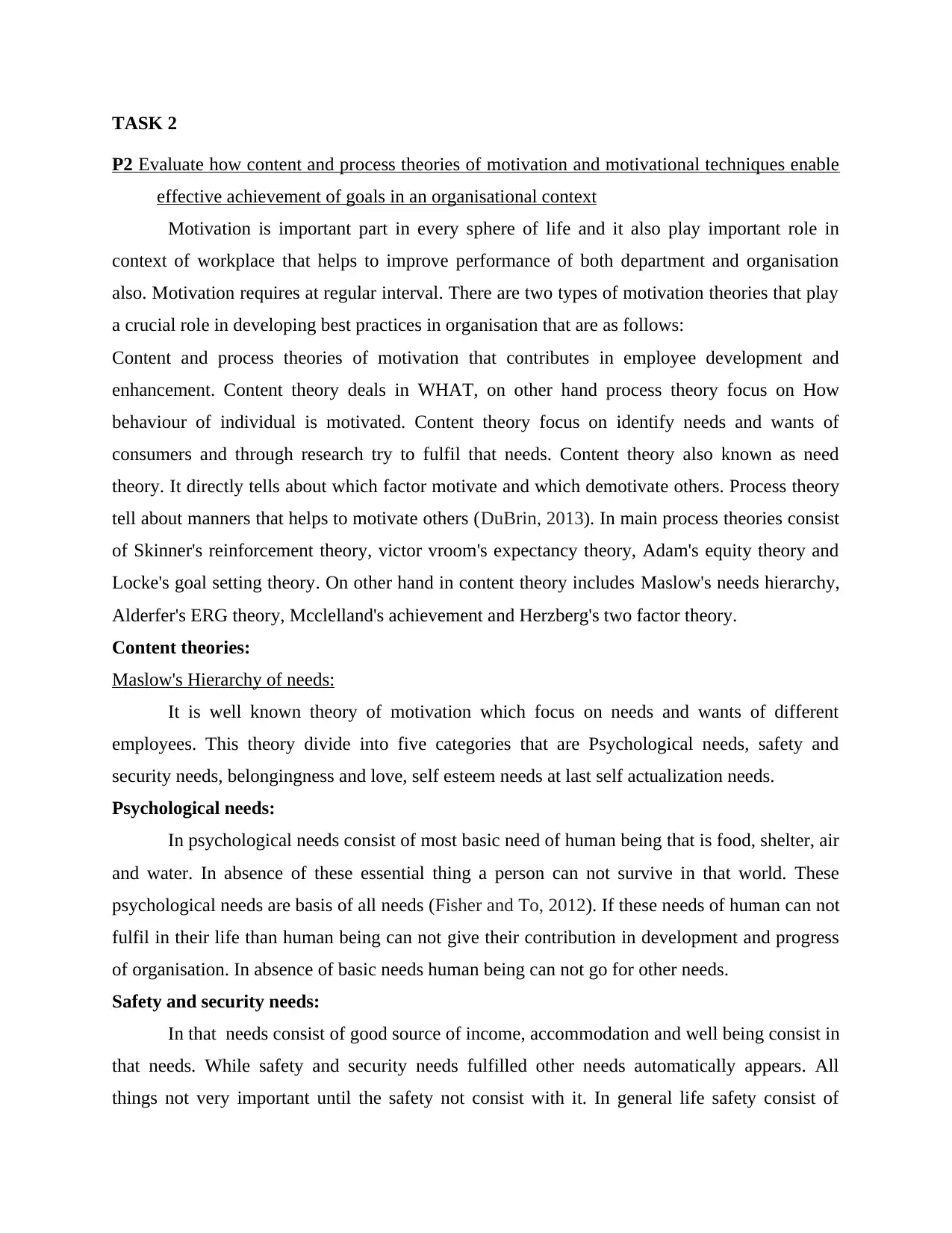
TASK 2
P2 Evaluate how content and process theories of motivation and motivational techniques enable
effective achievement of goals in an organisational context
Motivation is important part in every sphere of life and it also play important role in
context of workplace that helps to improve performance of both department and organisation
also. Motivation requires at regular interval. There are two types of motivation theories that play
a crucial role in developing best practices in organisation that are as follows:
Content and process theories of motivation that contributes in employee development and
enhancement. Content theory deals in WHAT, on other hand process theory focus on How
behaviour of individual is motivated. Content theory focus on identify needs and wants of
consumers and through research try to fulfil that needs. Content theory also known as need
theory. It directly tells about which factor motivate and which demotivate others. Process theory
tell about manners that helps to motivate others (DuBrin, 2013). In main process theories consist
of Skinner's reinforcement theory, victor vroom's expectancy theory, Adam's equity theory and
Locke's goal setting theory. On other hand in content theory includes Maslow's needs hierarchy,
Alderfer's ERG theory, Mcclelland's achievement and Herzberg's two factor theory.
Content theories:
Maslow's Hierarchy of needs:
It is well known theory of motivation which focus on needs and wants of different
employees. This theory divide into five categories that are Psychological needs, safety and
security needs, belongingness and love, self esteem needs at last self actualization needs.
Psychological needs:
In psychological needs consist of most basic need of human being that is food, shelter, air
and water. In absence of these essential thing a person can not survive in that world. These
psychological needs are basis of all needs (Fisher and To, 2012). If these needs of human can not
fulfil in their life than human being can not give their contribution in development and progress
of organisation. In absence of basic needs human being can not go for other needs.
Safety and security needs:
In that needs consist of good source of income, accommodation and well being consist in
that needs. While safety and security needs fulfilled other needs automatically appears. All
things not very important until the safety not consist with it. In general life safety consist of
P2 Evaluate how content and process theories of motivation and motivational techniques enable
effective achievement of goals in an organisational context
Motivation is important part in every sphere of life and it also play important role in
context of workplace that helps to improve performance of both department and organisation
also. Motivation requires at regular interval. There are two types of motivation theories that play
a crucial role in developing best practices in organisation that are as follows:
Content and process theories of motivation that contributes in employee development and
enhancement. Content theory deals in WHAT, on other hand process theory focus on How
behaviour of individual is motivated. Content theory focus on identify needs and wants of
consumers and through research try to fulfil that needs. Content theory also known as need
theory. It directly tells about which factor motivate and which demotivate others. Process theory
tell about manners that helps to motivate others (DuBrin, 2013). In main process theories consist
of Skinner's reinforcement theory, victor vroom's expectancy theory, Adam's equity theory and
Locke's goal setting theory. On other hand in content theory includes Maslow's needs hierarchy,
Alderfer's ERG theory, Mcclelland's achievement and Herzberg's two factor theory.
Content theories:
Maslow's Hierarchy of needs:
It is well known theory of motivation which focus on needs and wants of different
employees. This theory divide into five categories that are Psychological needs, safety and
security needs, belongingness and love, self esteem needs at last self actualization needs.
Psychological needs:
In psychological needs consist of most basic need of human being that is food, shelter, air
and water. In absence of these essential thing a person can not survive in that world. These
psychological needs are basis of all needs (Fisher and To, 2012). If these needs of human can not
fulfil in their life than human being can not give their contribution in development and progress
of organisation. In absence of basic needs human being can not go for other needs.
Safety and security needs:
In that needs consist of good source of income, accommodation and well being consist in
that needs. While safety and security needs fulfilled other needs automatically appears. All
things not very important until the safety not consist with it. In general life safety consist of
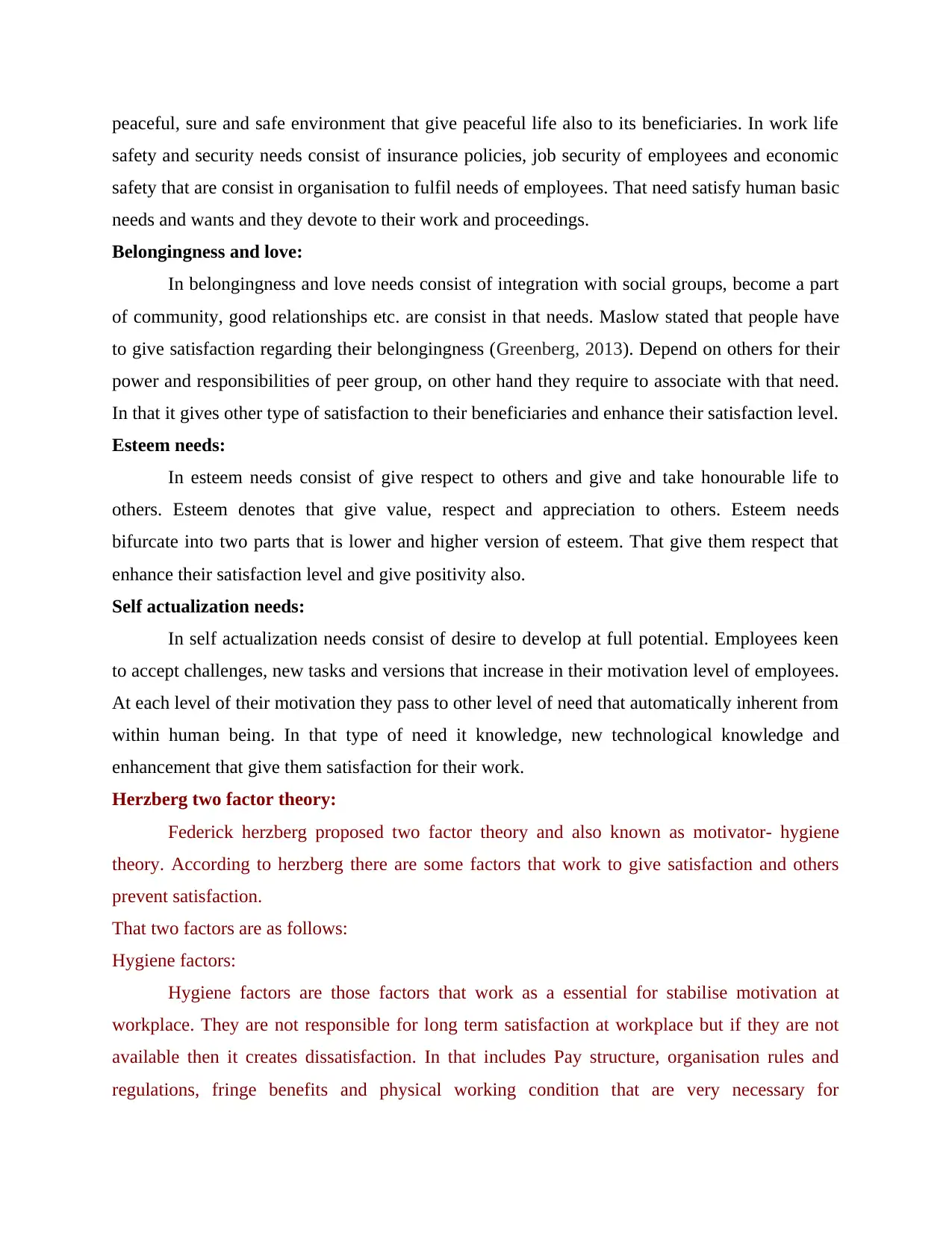
peaceful, sure and safe environment that give peaceful life also to its beneficiaries. In work life
safety and security needs consist of insurance policies, job security of employees and economic
safety that are consist in organisation to fulfil needs of employees. That need satisfy human basic
needs and wants and they devote to their work and proceedings.
Belongingness and love:
In belongingness and love needs consist of integration with social groups, become a part
of community, good relationships etc. are consist in that needs. Maslow stated that people have
to give satisfaction regarding their belongingness (Greenberg, 2013). Depend on others for their
power and responsibilities of peer group, on other hand they require to associate with that need.
In that it gives other type of satisfaction to their beneficiaries and enhance their satisfaction level.
Esteem needs:
In esteem needs consist of give respect to others and give and take honourable life to
others. Esteem denotes that give value, respect and appreciation to others. Esteem needs
bifurcate into two parts that is lower and higher version of esteem. That give them respect that
enhance their satisfaction level and give positivity also.
Self actualization needs:
In self actualization needs consist of desire to develop at full potential. Employees keen
to accept challenges, new tasks and versions that increase in their motivation level of employees.
At each level of their motivation they pass to other level of need that automatically inherent from
within human being. In that type of need it knowledge, new technological knowledge and
enhancement that give them satisfaction for their work.
Herzberg two factor theory:
Federick herzberg proposed two factor theory and also known as motivator- hygiene
theory. According to herzberg there are some factors that work to give satisfaction and others
prevent satisfaction.
That two factors are as follows:
Hygiene factors:
Hygiene factors are those factors that work as a essential for stabilise motivation at
workplace. They are not responsible for long term satisfaction at workplace but if they are not
available then it creates dissatisfaction. In that includes Pay structure, organisation rules and
regulations, fringe benefits and physical working condition that are very necessary for
safety and security needs consist of insurance policies, job security of employees and economic
safety that are consist in organisation to fulfil needs of employees. That need satisfy human basic
needs and wants and they devote to their work and proceedings.
Belongingness and love:
In belongingness and love needs consist of integration with social groups, become a part
of community, good relationships etc. are consist in that needs. Maslow stated that people have
to give satisfaction regarding their belongingness (Greenberg, 2013). Depend on others for their
power and responsibilities of peer group, on other hand they require to associate with that need.
In that it gives other type of satisfaction to their beneficiaries and enhance their satisfaction level.
Esteem needs:
In esteem needs consist of give respect to others and give and take honourable life to
others. Esteem denotes that give value, respect and appreciation to others. Esteem needs
bifurcate into two parts that is lower and higher version of esteem. That give them respect that
enhance their satisfaction level and give positivity also.
Self actualization needs:
In self actualization needs consist of desire to develop at full potential. Employees keen
to accept challenges, new tasks and versions that increase in their motivation level of employees.
At each level of their motivation they pass to other level of need that automatically inherent from
within human being. In that type of need it knowledge, new technological knowledge and
enhancement that give them satisfaction for their work.
Herzberg two factor theory:
Federick herzberg proposed two factor theory and also known as motivator- hygiene
theory. According to herzberg there are some factors that work to give satisfaction and others
prevent satisfaction.
That two factors are as follows:
Hygiene factors:
Hygiene factors are those factors that work as a essential for stabilise motivation at
workplace. They are not responsible for long term satisfaction at workplace but if they are not
available then it creates dissatisfaction. In that includes Pay structure, organisation rules and
regulations, fringe benefits and physical working condition that are very necessary for

motivation level of employees. In case of 1spatial they give best working conditions to their
employees to give their best in organisational development.
Motivational factors:
According to Herzberg, Hygiene factor not consider as a motivational factor. In
motivation factor gives positive satisfaction. They are inherent for employees in which includes
recognition to employees,sense of achievement, roles and responsibilities with give appreciation
for meaningfulness to work. In case of 1spatial they give reward to their employees time to time
for enhance their motivation level.
Process theory:
In process theory there are different theories consist in it. But best theory to understand
need of employees and to motivate them is Adam's Equity theory.
Adam's Equity theory:
This theory states that best source of motivation for people is to treat them in equal
manner and in return organisation get fair efforts and costs. This theory based on social exchange
theory of motivation. According to that theory employee in organisation compare and contrast
their work and cost of their efforts and in that benefits that come out from their efforts. An
employee always want that input-output ratio always be equal and if it exist in unequal manner
that unsatisfying an employee (Huczynski ,Buchananand Huczynski, 2013). On workplace an
employee in form of inputs give their efforts, time, education, experience, energy and other
things. In result employee wants good salary, remuneration, appraisals and reward, promotions
and other recognitions and challenging work that path for career advancement in its growth. So
inequality in input and output dissatisfying employees and impacts negative on employee
productivity. So there should be equality between input and output ratio of their contribution in
workplace. So that they become satisfy from their work and its work proceedings hence they
give their best to organisation.
So these motivation theories helps to understand human behaviour and give effectiveness
in achieving organisational goals and objectives in 1spatial.
Vroom expectancy motivation theory:
Vroom theory of expectancy based on individual behaviour from conscious choice from
different choices to gain maximum profit by eliminating pains. Vroom focuses on employee
performance that depends on different factors that are their personality, knowledge, skill set,
employees to give their best in organisational development.
Motivational factors:
According to Herzberg, Hygiene factor not consider as a motivational factor. In
motivation factor gives positive satisfaction. They are inherent for employees in which includes
recognition to employees,sense of achievement, roles and responsibilities with give appreciation
for meaningfulness to work. In case of 1spatial they give reward to their employees time to time
for enhance their motivation level.
Process theory:
In process theory there are different theories consist in it. But best theory to understand
need of employees and to motivate them is Adam's Equity theory.
Adam's Equity theory:
This theory states that best source of motivation for people is to treat them in equal
manner and in return organisation get fair efforts and costs. This theory based on social exchange
theory of motivation. According to that theory employee in organisation compare and contrast
their work and cost of their efforts and in that benefits that come out from their efforts. An
employee always want that input-output ratio always be equal and if it exist in unequal manner
that unsatisfying an employee (Huczynski ,Buchananand Huczynski, 2013). On workplace an
employee in form of inputs give their efforts, time, education, experience, energy and other
things. In result employee wants good salary, remuneration, appraisals and reward, promotions
and other recognitions and challenging work that path for career advancement in its growth. So
inequality in input and output dissatisfying employees and impacts negative on employee
productivity. So there should be equality between input and output ratio of their contribution in
workplace. So that they become satisfy from their work and its work proceedings hence they
give their best to organisation.
So these motivation theories helps to understand human behaviour and give effectiveness
in achieving organisational goals and objectives in 1spatial.
Vroom expectancy motivation theory:
Vroom theory of expectancy based on individual behaviour from conscious choice from
different choices to gain maximum profit by eliminating pains. Vroom focuses on employee
performance that depends on different factors that are their personality, knowledge, skill set,
Secure Best Marks with AI Grader
Need help grading? Try our AI Grader for instant feedback on your assignments.
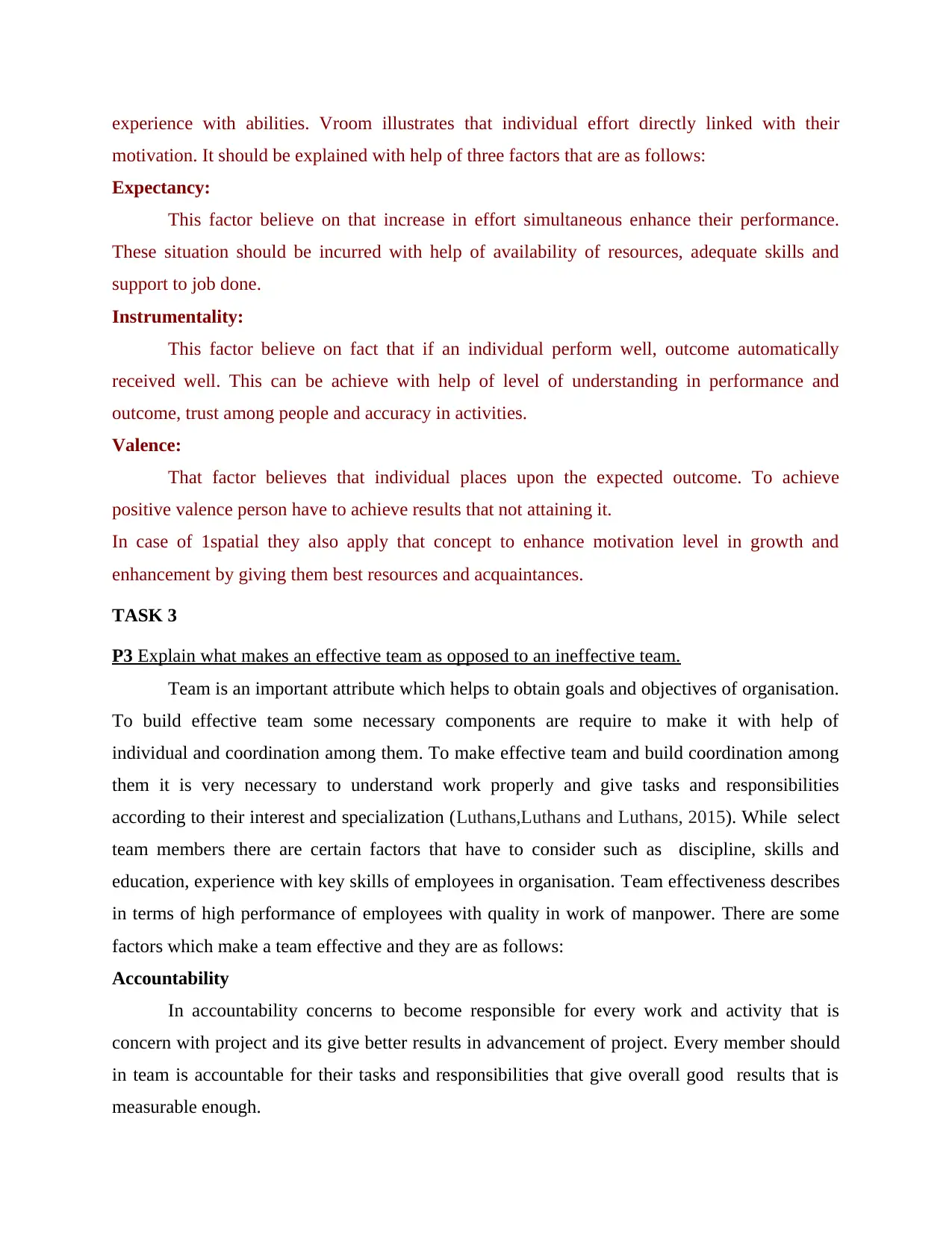
experience with abilities. Vroom illustrates that individual effort directly linked with their
motivation. It should be explained with help of three factors that are as follows:
Expectancy:
This factor believe on that increase in effort simultaneous enhance their performance.
These situation should be incurred with help of availability of resources, adequate skills and
support to job done.
Instrumentality:
This factor believe on fact that if an individual perform well, outcome automatically
received well. This can be achieve with help of level of understanding in performance and
outcome, trust among people and accuracy in activities.
Valence:
That factor believes that individual places upon the expected outcome. To achieve
positive valence person have to achieve results that not attaining it.
In case of 1spatial they also apply that concept to enhance motivation level in growth and
enhancement by giving them best resources and acquaintances.
TASK 3
P3 Explain what makes an effective team as opposed to an ineffective team.
Team is an important attribute which helps to obtain goals and objectives of organisation.
To build effective team some necessary components are require to make it with help of
individual and coordination among them. To make effective team and build coordination among
them it is very necessary to understand work properly and give tasks and responsibilities
according to their interest and specialization (Luthans,Luthans and Luthans, 2015). While select
team members there are certain factors that have to consider such as discipline, skills and
education, experience with key skills of employees in organisation. Team effectiveness describes
in terms of high performance of employees with quality in work of manpower. There are some
factors which make a team effective and they are as follows:
Accountability
In accountability concerns to become responsible for every work and activity that is
concern with project and its give better results in advancement of project. Every member should
in team is accountable for their tasks and responsibilities that give overall good results that is
measurable enough.
motivation. It should be explained with help of three factors that are as follows:
Expectancy:
This factor believe on that increase in effort simultaneous enhance their performance.
These situation should be incurred with help of availability of resources, adequate skills and
support to job done.
Instrumentality:
This factor believe on fact that if an individual perform well, outcome automatically
received well. This can be achieve with help of level of understanding in performance and
outcome, trust among people and accuracy in activities.
Valence:
That factor believes that individual places upon the expected outcome. To achieve
positive valence person have to achieve results that not attaining it.
In case of 1spatial they also apply that concept to enhance motivation level in growth and
enhancement by giving them best resources and acquaintances.
TASK 3
P3 Explain what makes an effective team as opposed to an ineffective team.
Team is an important attribute which helps to obtain goals and objectives of organisation.
To build effective team some necessary components are require to make it with help of
individual and coordination among them. To make effective team and build coordination among
them it is very necessary to understand work properly and give tasks and responsibilities
according to their interest and specialization (Luthans,Luthans and Luthans, 2015). While select
team members there are certain factors that have to consider such as discipline, skills and
education, experience with key skills of employees in organisation. Team effectiveness describes
in terms of high performance of employees with quality in work of manpower. There are some
factors which make a team effective and they are as follows:
Accountability
In accountability concerns to become responsible for every work and activity that is
concern with project and its give better results in advancement of project. Every member should
in team is accountable for their tasks and responsibilities that give overall good results that is
measurable enough.
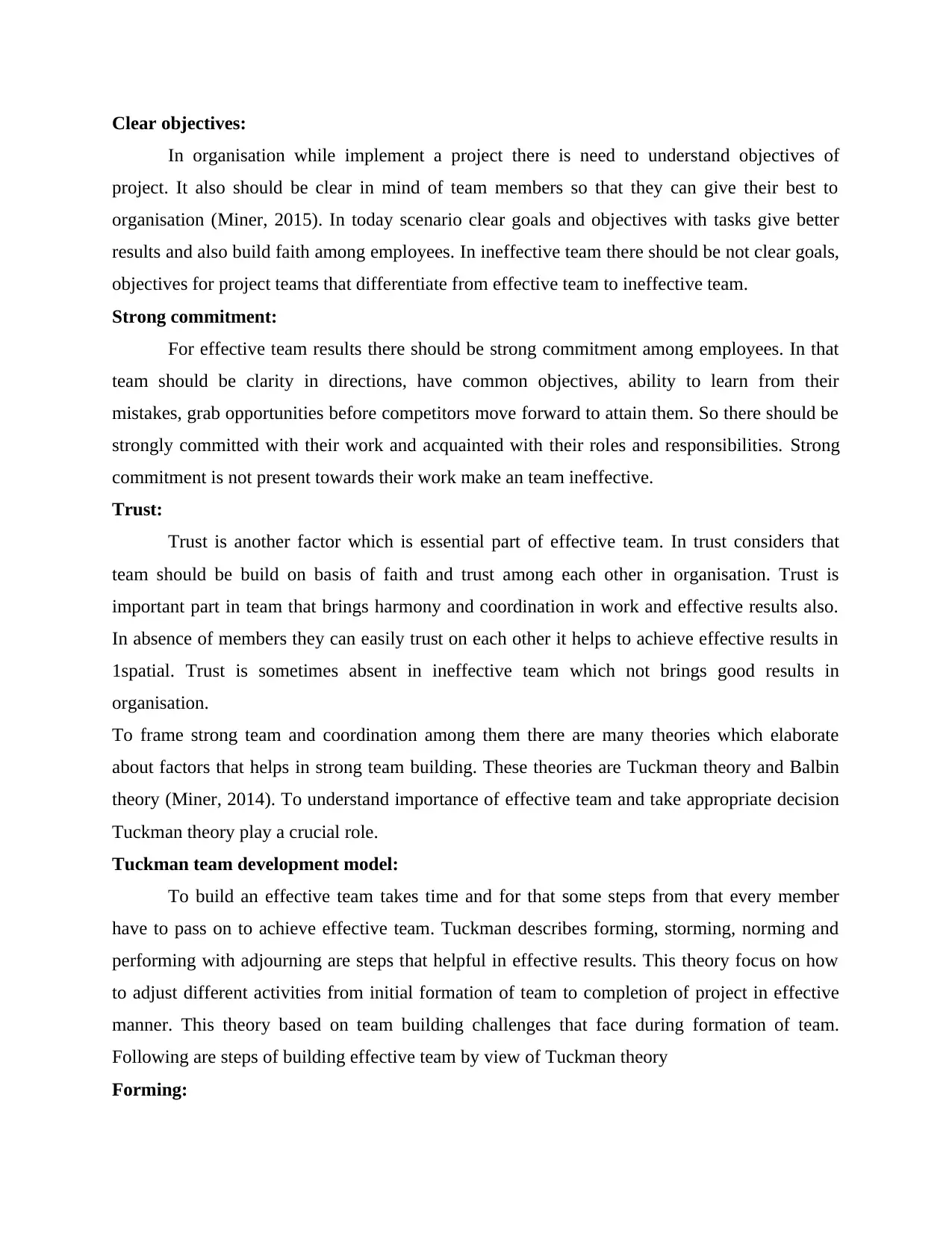
Clear objectives:
In organisation while implement a project there is need to understand objectives of
project. It also should be clear in mind of team members so that they can give their best to
organisation (Miner, 2015). In today scenario clear goals and objectives with tasks give better
results and also build faith among employees. In ineffective team there should be not clear goals,
objectives for project teams that differentiate from effective team to ineffective team.
Strong commitment:
For effective team results there should be strong commitment among employees. In that
team should be clarity in directions, have common objectives, ability to learn from their
mistakes, grab opportunities before competitors move forward to attain them. So there should be
strongly committed with their work and acquainted with their roles and responsibilities. Strong
commitment is not present towards their work make an team ineffective.
Trust:
Trust is another factor which is essential part of effective team. In trust considers that
team should be build on basis of faith and trust among each other in organisation. Trust is
important part in team that brings harmony and coordination in work and effective results also.
In absence of members they can easily trust on each other it helps to achieve effective results in
1spatial. Trust is sometimes absent in ineffective team which not brings good results in
organisation.
To frame strong team and coordination among them there are many theories which elaborate
about factors that helps in strong team building. These theories are Tuckman theory and Balbin
theory (Miner, 2014). To understand importance of effective team and take appropriate decision
Tuckman theory play a crucial role.
Tuckman team development model:
To build an effective team takes time and for that some steps from that every member
have to pass on to achieve effective team. Tuckman describes forming, storming, norming and
performing with adjourning are steps that helpful in effective results. This theory focus on how
to adjust different activities from initial formation of team to completion of project in effective
manner. This theory based on team building challenges that face during formation of team.
Following are steps of building effective team by view of Tuckman theory
Forming:
In organisation while implement a project there is need to understand objectives of
project. It also should be clear in mind of team members so that they can give their best to
organisation (Miner, 2015). In today scenario clear goals and objectives with tasks give better
results and also build faith among employees. In ineffective team there should be not clear goals,
objectives for project teams that differentiate from effective team to ineffective team.
Strong commitment:
For effective team results there should be strong commitment among employees. In that
team should be clarity in directions, have common objectives, ability to learn from their
mistakes, grab opportunities before competitors move forward to attain them. So there should be
strongly committed with their work and acquainted with their roles and responsibilities. Strong
commitment is not present towards their work make an team ineffective.
Trust:
Trust is another factor which is essential part of effective team. In trust considers that
team should be build on basis of faith and trust among each other in organisation. Trust is
important part in team that brings harmony and coordination in work and effective results also.
In absence of members they can easily trust on each other it helps to achieve effective results in
1spatial. Trust is sometimes absent in ineffective team which not brings good results in
organisation.
To frame strong team and coordination among them there are many theories which elaborate
about factors that helps in strong team building. These theories are Tuckman theory and Balbin
theory (Miner, 2014). To understand importance of effective team and take appropriate decision
Tuckman theory play a crucial role.
Tuckman team development model:
To build an effective team takes time and for that some steps from that every member
have to pass on to achieve effective team. Tuckman describes forming, storming, norming and
performing with adjourning are steps that helpful in effective results. This theory focus on how
to adjust different activities from initial formation of team to completion of project in effective
manner. This theory based on team building challenges that face during formation of team.
Following are steps of building effective team by view of Tuckman theory
Forming:
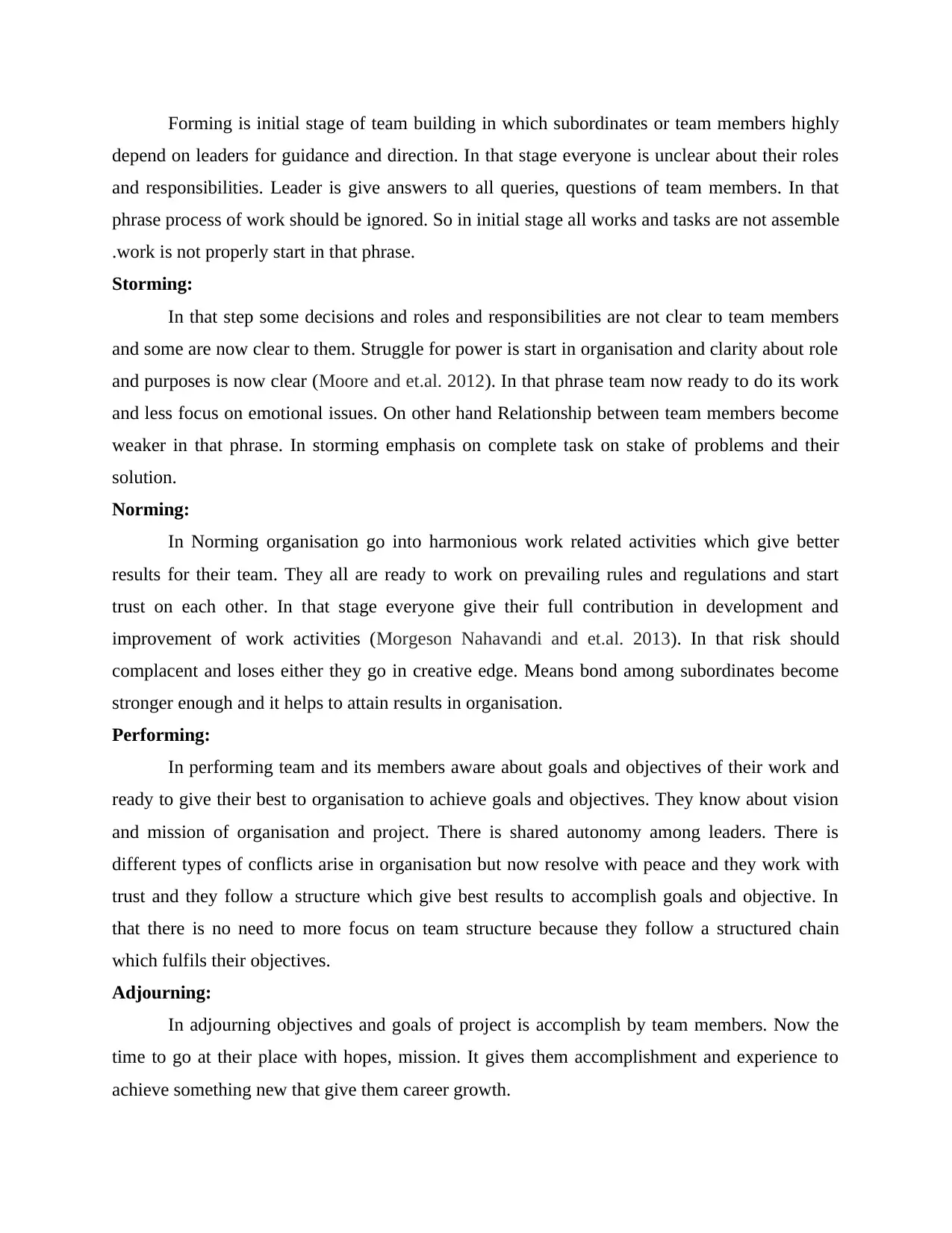
Forming is initial stage of team building in which subordinates or team members highly
depend on leaders for guidance and direction. In that stage everyone is unclear about their roles
and responsibilities. Leader is give answers to all queries, questions of team members. In that
phrase process of work should be ignored. So in initial stage all works and tasks are not assemble
.work is not properly start in that phrase.
Storming:
In that step some decisions and roles and responsibilities are not clear to team members
and some are now clear to them. Struggle for power is start in organisation and clarity about role
and purposes is now clear (Moore and et.al. 2012). In that phrase team now ready to do its work
and less focus on emotional issues. On other hand Relationship between team members become
weaker in that phrase. In storming emphasis on complete task on stake of problems and their
solution.
Norming:
In Norming organisation go into harmonious work related activities which give better
results for their team. They all are ready to work on prevailing rules and regulations and start
trust on each other. In that stage everyone give their full contribution in development and
improvement of work activities (Morgeson Nahavandi and et.al. 2013). In that risk should
complacent and loses either they go in creative edge. Means bond among subordinates become
stronger enough and it helps to attain results in organisation.
Performing:
In performing team and its members aware about goals and objectives of their work and
ready to give their best to organisation to achieve goals and objectives. They know about vision
and mission of organisation and project. There is shared autonomy among leaders. There is
different types of conflicts arise in organisation but now resolve with peace and they work with
trust and they follow a structure which give best results to accomplish goals and objective. In
that there is no need to more focus on team structure because they follow a structured chain
which fulfils their objectives.
Adjourning:
In adjourning objectives and goals of project is accomplish by team members. Now the
time to go at their place with hopes, mission. It gives them accomplishment and experience to
achieve something new that give them career growth.
depend on leaders for guidance and direction. In that stage everyone is unclear about their roles
and responsibilities. Leader is give answers to all queries, questions of team members. In that
phrase process of work should be ignored. So in initial stage all works and tasks are not assemble
.work is not properly start in that phrase.
Storming:
In that step some decisions and roles and responsibilities are not clear to team members
and some are now clear to them. Struggle for power is start in organisation and clarity about role
and purposes is now clear (Moore and et.al. 2012). In that phrase team now ready to do its work
and less focus on emotional issues. On other hand Relationship between team members become
weaker in that phrase. In storming emphasis on complete task on stake of problems and their
solution.
Norming:
In Norming organisation go into harmonious work related activities which give better
results for their team. They all are ready to work on prevailing rules and regulations and start
trust on each other. In that stage everyone give their full contribution in development and
improvement of work activities (Morgeson Nahavandi and et.al. 2013). In that risk should
complacent and loses either they go in creative edge. Means bond among subordinates become
stronger enough and it helps to attain results in organisation.
Performing:
In performing team and its members aware about goals and objectives of their work and
ready to give their best to organisation to achieve goals and objectives. They know about vision
and mission of organisation and project. There is shared autonomy among leaders. There is
different types of conflicts arise in organisation but now resolve with peace and they work with
trust and they follow a structure which give best results to accomplish goals and objective. In
that there is no need to more focus on team structure because they follow a structured chain
which fulfils their objectives.
Adjourning:
In adjourning objectives and goals of project is accomplish by team members. Now the
time to go at their place with hopes, mission. It gives them accomplishment and experience to
achieve something new that give them career growth.
Paraphrase This Document
Need a fresh take? Get an instant paraphrase of this document with our AI Paraphraser
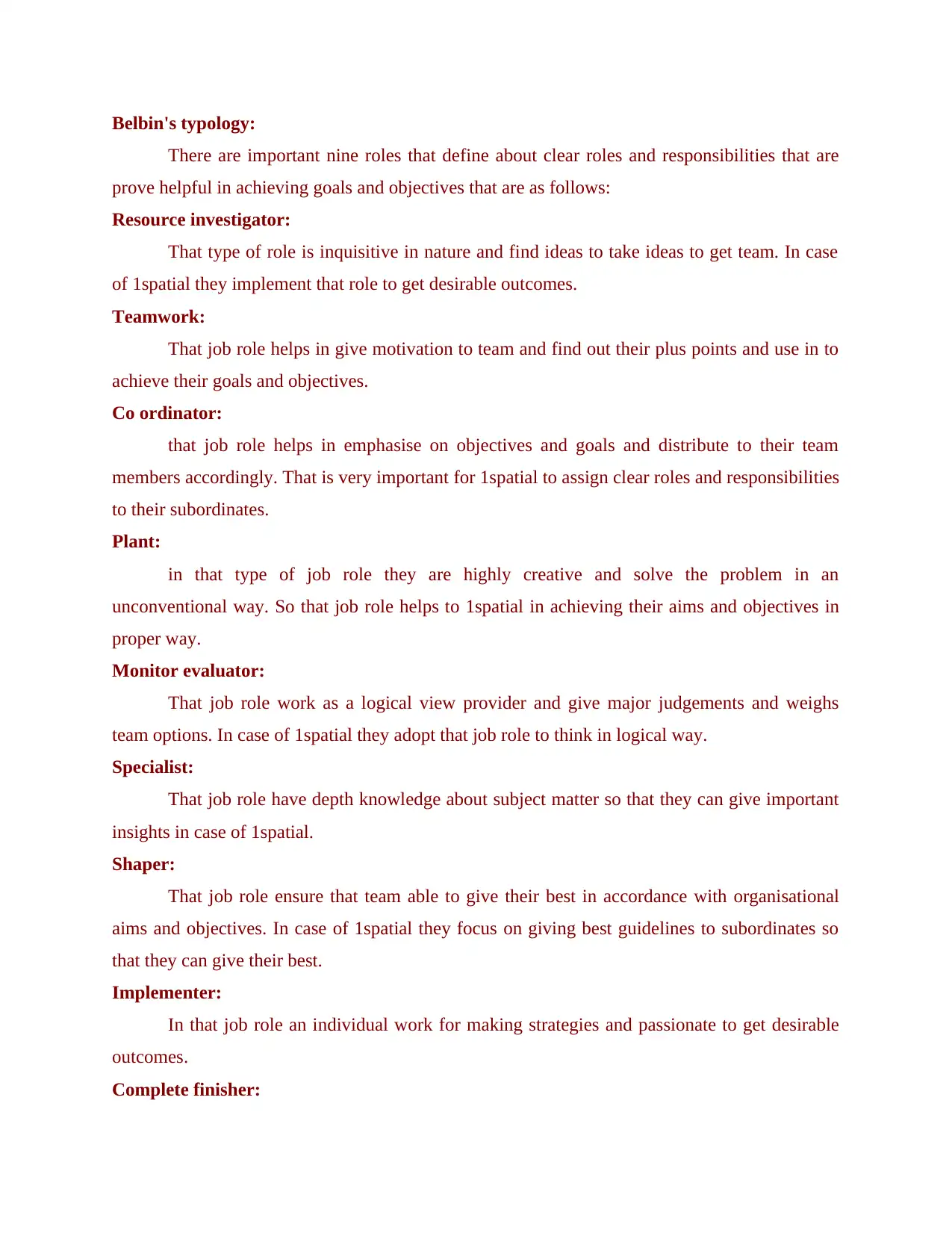
Belbin's typology:
There are important nine roles that define about clear roles and responsibilities that are
prove helpful in achieving goals and objectives that are as follows:
Resource investigator:
That type of role is inquisitive in nature and find ideas to take ideas to get team. In case
of 1spatial they implement that role to get desirable outcomes.
Teamwork:
That job role helps in give motivation to team and find out their plus points and use in to
achieve their goals and objectives.
Co ordinator:
that job role helps in emphasise on objectives and goals and distribute to their team
members accordingly. That is very important for 1spatial to assign clear roles and responsibilities
to their subordinates.
Plant:
in that type of job role they are highly creative and solve the problem in an
unconventional way. So that job role helps to 1spatial in achieving their aims and objectives in
proper way.
Monitor evaluator:
That job role work as a logical view provider and give major judgements and weighs
team options. In case of 1spatial they adopt that job role to think in logical way.
Specialist:
That job role have depth knowledge about subject matter so that they can give important
insights in case of 1spatial.
Shaper:
That job role ensure that team able to give their best in accordance with organisational
aims and objectives. In case of 1spatial they focus on giving best guidelines to subordinates so
that they can give their best.
Implementer:
In that job role an individual work for making strategies and passionate to get desirable
outcomes.
Complete finisher:
There are important nine roles that define about clear roles and responsibilities that are
prove helpful in achieving goals and objectives that are as follows:
Resource investigator:
That type of role is inquisitive in nature and find ideas to take ideas to get team. In case
of 1spatial they implement that role to get desirable outcomes.
Teamwork:
That job role helps in give motivation to team and find out their plus points and use in to
achieve their goals and objectives.
Co ordinator:
that job role helps in emphasise on objectives and goals and distribute to their team
members accordingly. That is very important for 1spatial to assign clear roles and responsibilities
to their subordinates.
Plant:
in that type of job role they are highly creative and solve the problem in an
unconventional way. So that job role helps to 1spatial in achieving their aims and objectives in
proper way.
Monitor evaluator:
That job role work as a logical view provider and give major judgements and weighs
team options. In case of 1spatial they adopt that job role to think in logical way.
Specialist:
That job role have depth knowledge about subject matter so that they can give important
insights in case of 1spatial.
Shaper:
That job role ensure that team able to give their best in accordance with organisational
aims and objectives. In case of 1spatial they focus on giving best guidelines to subordinates so
that they can give their best.
Implementer:
In that job role an individual work for making strategies and passionate to get desirable
outcomes.
Complete finisher:
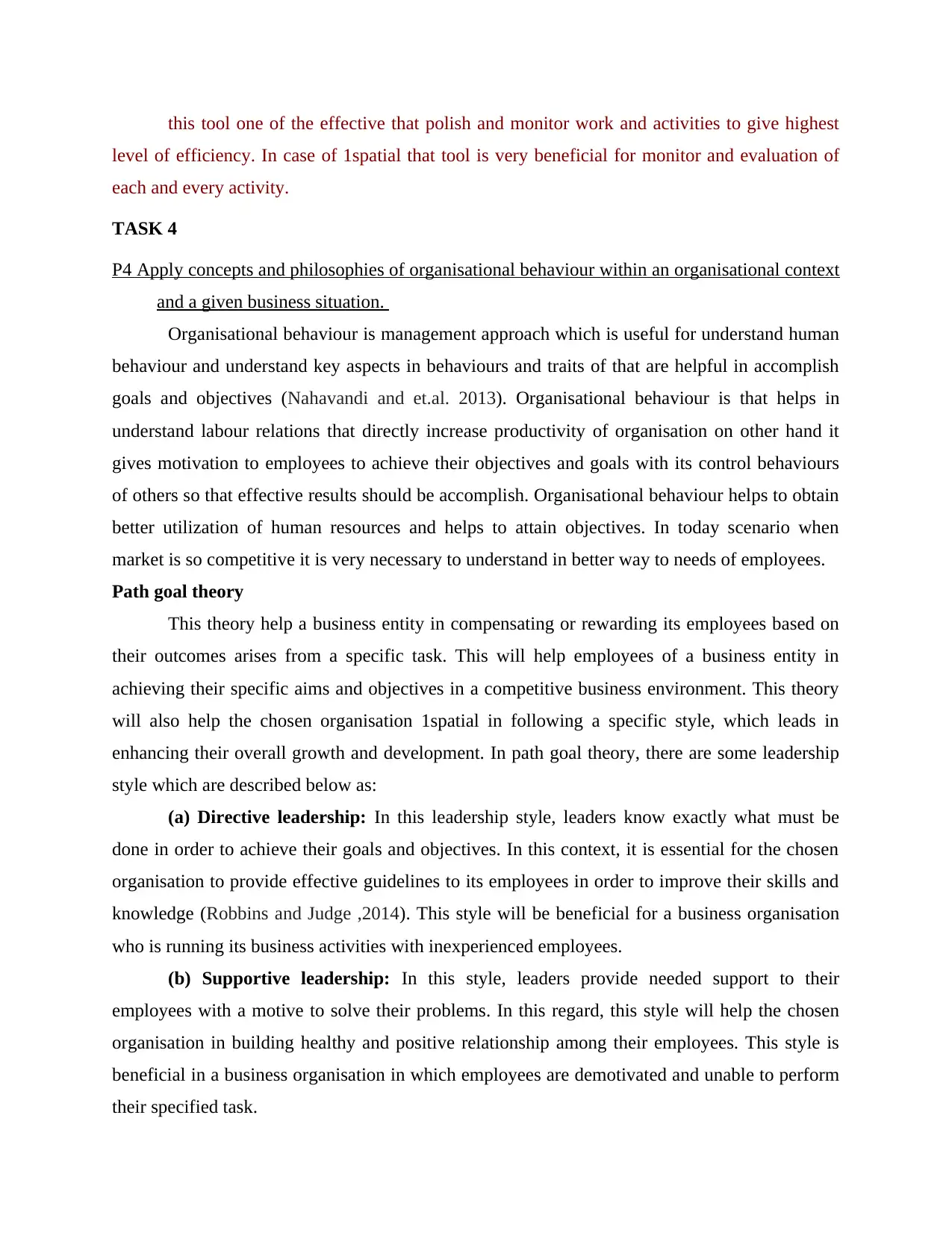
this tool one of the effective that polish and monitor work and activities to give highest
level of efficiency. In case of 1spatial that tool is very beneficial for monitor and evaluation of
each and every activity.
TASK 4
P4 Apply concepts and philosophies of organisational behaviour within an organisational context
and a given business situation.
Organisational behaviour is management approach which is useful for understand human
behaviour and understand key aspects in behaviours and traits of that are helpful in accomplish
goals and objectives (Nahavandi and et.al. 2013). Organisational behaviour is that helps in
understand labour relations that directly increase productivity of organisation on other hand it
gives motivation to employees to achieve their objectives and goals with its control behaviours
of others so that effective results should be accomplish. Organisational behaviour helps to obtain
better utilization of human resources and helps to attain objectives. In today scenario when
market is so competitive it is very necessary to understand in better way to needs of employees.
Path goal theory
This theory help a business entity in compensating or rewarding its employees based on
their outcomes arises from a specific task. This will help employees of a business entity in
achieving their specific aims and objectives in a competitive business environment. This theory
will also help the chosen organisation 1spatial in following a specific style, which leads in
enhancing their overall growth and development. In path goal theory, there are some leadership
style which are described below as:
(a) Directive leadership: In this leadership style, leaders know exactly what must be
done in order to achieve their goals and objectives. In this context, it is essential for the chosen
organisation to provide effective guidelines to its employees in order to improve their skills and
knowledge (Robbins and Judge ,2014). This style will be beneficial for a business organisation
who is running its business activities with inexperienced employees.
(b) Supportive leadership: In this style, leaders provide needed support to their
employees with a motive to solve their problems. In this regard, this style will help the chosen
organisation in building healthy and positive relationship among their employees. This style is
beneficial in a business organisation in which employees are demotivated and unable to perform
their specified task.
level of efficiency. In case of 1spatial that tool is very beneficial for monitor and evaluation of
each and every activity.
TASK 4
P4 Apply concepts and philosophies of organisational behaviour within an organisational context
and a given business situation.
Organisational behaviour is management approach which is useful for understand human
behaviour and understand key aspects in behaviours and traits of that are helpful in accomplish
goals and objectives (Nahavandi and et.al. 2013). Organisational behaviour is that helps in
understand labour relations that directly increase productivity of organisation on other hand it
gives motivation to employees to achieve their objectives and goals with its control behaviours
of others so that effective results should be accomplish. Organisational behaviour helps to obtain
better utilization of human resources and helps to attain objectives. In today scenario when
market is so competitive it is very necessary to understand in better way to needs of employees.
Path goal theory
This theory help a business entity in compensating or rewarding its employees based on
their outcomes arises from a specific task. This will help employees of a business entity in
achieving their specific aims and objectives in a competitive business environment. This theory
will also help the chosen organisation 1spatial in following a specific style, which leads in
enhancing their overall growth and development. In path goal theory, there are some leadership
style which are described below as:
(a) Directive leadership: In this leadership style, leaders know exactly what must be
done in order to achieve their goals and objectives. In this context, it is essential for the chosen
organisation to provide effective guidelines to its employees in order to improve their skills and
knowledge (Robbins and Judge ,2014). This style will be beneficial for a business organisation
who is running its business activities with inexperienced employees.
(b) Supportive leadership: In this style, leaders provide needed support to their
employees with a motive to solve their problems. In this regard, this style will help the chosen
organisation in building healthy and positive relationship among their employees. This style is
beneficial in a business organisation in which employees are demotivated and unable to perform
their specified task.
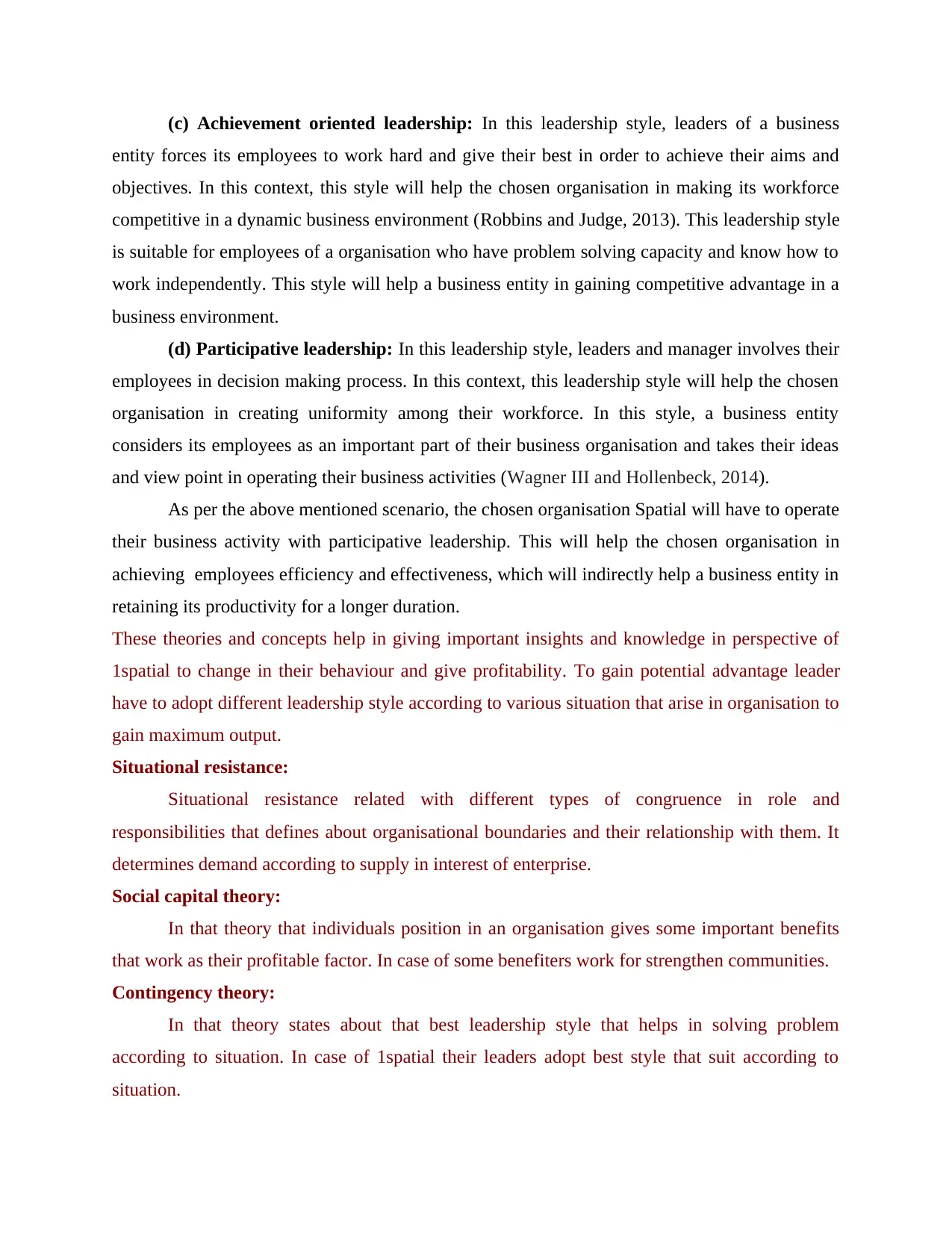
(c) Achievement oriented leadership: In this leadership style, leaders of a business
entity forces its employees to work hard and give their best in order to achieve their aims and
objectives. In this context, this style will help the chosen organisation in making its workforce
competitive in a dynamic business environment (Robbins and Judge, 2013). This leadership style
is suitable for employees of a organisation who have problem solving capacity and know how to
work independently. This style will help a business entity in gaining competitive advantage in a
business environment.
(d) Participative leadership: In this leadership style, leaders and manager involves their
employees in decision making process. In this context, this leadership style will help the chosen
organisation in creating uniformity among their workforce. In this style, a business entity
considers its employees as an important part of their business organisation and takes their ideas
and view point in operating their business activities (Wagner III and Hollenbeck, 2014).
As per the above mentioned scenario, the chosen organisation Spatial will have to operate
their business activity with participative leadership. This will help the chosen organisation in
achieving employees efficiency and effectiveness, which will indirectly help a business entity in
retaining its productivity for a longer duration.
These theories and concepts help in giving important insights and knowledge in perspective of
1spatial to change in their behaviour and give profitability. To gain potential advantage leader
have to adopt different leadership style according to various situation that arise in organisation to
gain maximum output.
Situational resistance:
Situational resistance related with different types of congruence in role and
responsibilities that defines about organisational boundaries and their relationship with them. It
determines demand according to supply in interest of enterprise.
Social capital theory:
In that theory that individuals position in an organisation gives some important benefits
that work as their profitable factor. In case of some benefiters work for strengthen communities.
Contingency theory:
In that theory states about that best leadership style that helps in solving problem
according to situation. In case of 1spatial their leaders adopt best style that suit according to
situation.
entity forces its employees to work hard and give their best in order to achieve their aims and
objectives. In this context, this style will help the chosen organisation in making its workforce
competitive in a dynamic business environment (Robbins and Judge, 2013). This leadership style
is suitable for employees of a organisation who have problem solving capacity and know how to
work independently. This style will help a business entity in gaining competitive advantage in a
business environment.
(d) Participative leadership: In this leadership style, leaders and manager involves their
employees in decision making process. In this context, this leadership style will help the chosen
organisation in creating uniformity among their workforce. In this style, a business entity
considers its employees as an important part of their business organisation and takes their ideas
and view point in operating their business activities (Wagner III and Hollenbeck, 2014).
As per the above mentioned scenario, the chosen organisation Spatial will have to operate
their business activity with participative leadership. This will help the chosen organisation in
achieving employees efficiency and effectiveness, which will indirectly help a business entity in
retaining its productivity for a longer duration.
These theories and concepts help in giving important insights and knowledge in perspective of
1spatial to change in their behaviour and give profitability. To gain potential advantage leader
have to adopt different leadership style according to various situation that arise in organisation to
gain maximum output.
Situational resistance:
Situational resistance related with different types of congruence in role and
responsibilities that defines about organisational boundaries and their relationship with them. It
determines demand according to supply in interest of enterprise.
Social capital theory:
In that theory that individuals position in an organisation gives some important benefits
that work as their profitable factor. In case of some benefiters work for strengthen communities.
Contingency theory:
In that theory states about that best leadership style that helps in solving problem
according to situation. In case of 1spatial their leaders adopt best style that suit according to
situation.
Secure Best Marks with AI Grader
Need help grading? Try our AI Grader for instant feedback on your assignments.
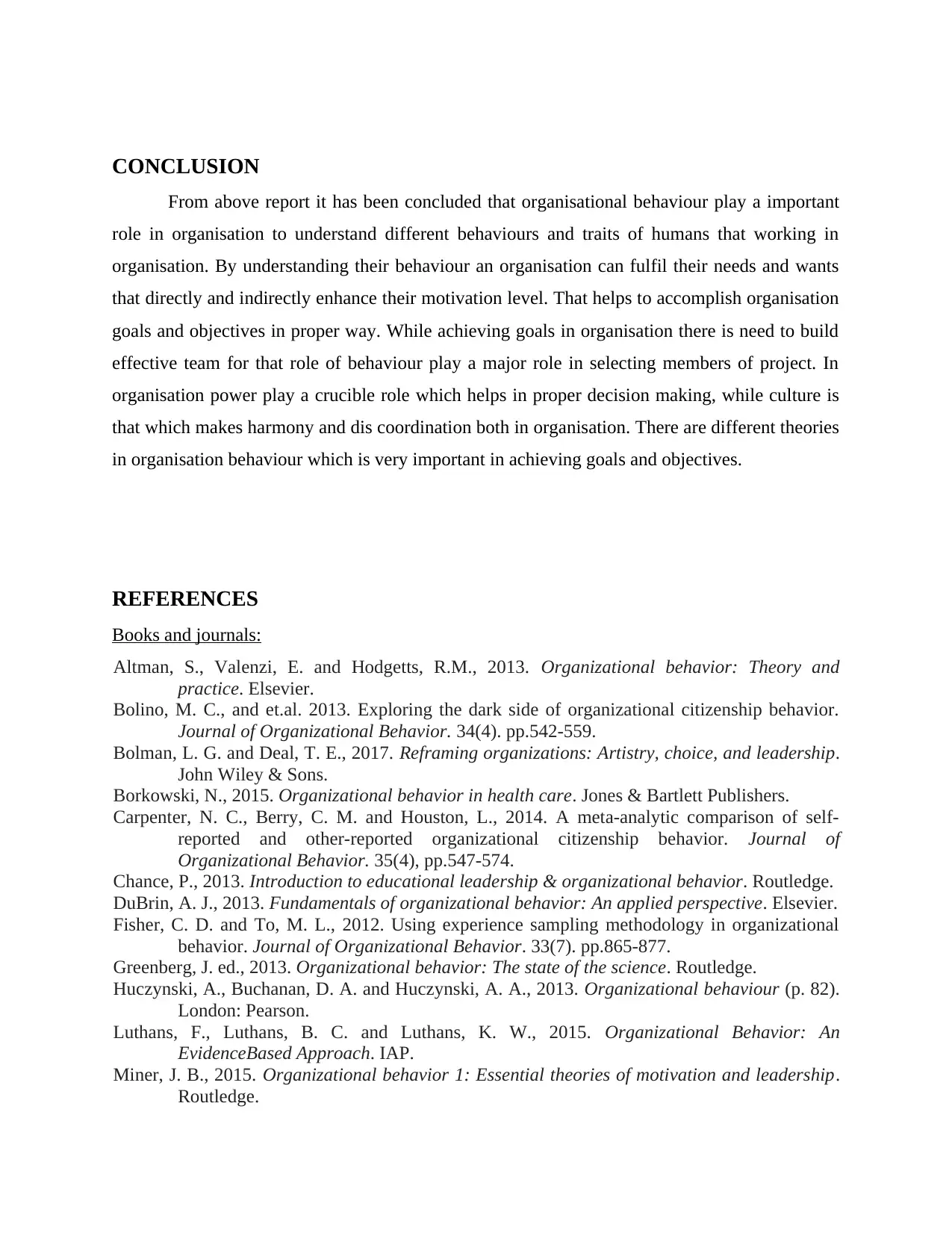
CONCLUSION
From above report it has been concluded that organisational behaviour play a important
role in organisation to understand different behaviours and traits of humans that working in
organisation. By understanding their behaviour an organisation can fulfil their needs and wants
that directly and indirectly enhance their motivation level. That helps to accomplish organisation
goals and objectives in proper way. While achieving goals in organisation there is need to build
effective team for that role of behaviour play a major role in selecting members of project. In
organisation power play a crucible role which helps in proper decision making, while culture is
that which makes harmony and dis coordination both in organisation. There are different theories
in organisation behaviour which is very important in achieving goals and objectives.
REFERENCES
Books and journals:
Altman, S., Valenzi, E. and Hodgetts, R.M., 2013. Organizational behavior: Theory and
practice. Elsevier.
Bolino, M. C., and et.al. 2013. Exploring the dark side of organizational citizenship behavior.
Journal of Organizational Behavior. 34(4). pp.542-559.
Bolman, L. G. and Deal, T. E., 2017. Reframing organizations: Artistry, choice, and leadership.
John Wiley & Sons.
Borkowski, N., 2015. Organizational behavior in health care. Jones & Bartlett Publishers.
Carpenter, N. C., Berry, C. M. and Houston, L., 2014. A meta‐analytic comparison of self‐
reported and other‐reported organizational citizenship behavior. Journal of
Organizational Behavior. 35(4), pp.547-574.
Chance, P., 2013. Introduction to educational leadership & organizational behavior. Routledge.
DuBrin, A. J., 2013. Fundamentals of organizational behavior: An applied perspective. Elsevier.
Fisher, C. D. and To, M. L., 2012. Using experience sampling methodology in organizational
behavior. Journal of Organizational Behavior. 33(7). pp.865-877.
Greenberg, J. ed., 2013. Organizational behavior: The state of the science. Routledge.
Huczynski, A., Buchanan, D. A. and Huczynski, A. A., 2013. Organizational behaviour (p. 82).
London: Pearson.
Luthans, F., Luthans, B. C. and Luthans, K. W., 2015. Organizational Behavior: An
EvidenceBased Approach. IAP.
Miner, J. B., 2015. Organizational behavior 1: Essential theories of motivation and leadership.
Routledge.
From above report it has been concluded that organisational behaviour play a important
role in organisation to understand different behaviours and traits of humans that working in
organisation. By understanding their behaviour an organisation can fulfil their needs and wants
that directly and indirectly enhance their motivation level. That helps to accomplish organisation
goals and objectives in proper way. While achieving goals in organisation there is need to build
effective team for that role of behaviour play a major role in selecting members of project. In
organisation power play a crucible role which helps in proper decision making, while culture is
that which makes harmony and dis coordination both in organisation. There are different theories
in organisation behaviour which is very important in achieving goals and objectives.
REFERENCES
Books and journals:
Altman, S., Valenzi, E. and Hodgetts, R.M., 2013. Organizational behavior: Theory and
practice. Elsevier.
Bolino, M. C., and et.al. 2013. Exploring the dark side of organizational citizenship behavior.
Journal of Organizational Behavior. 34(4). pp.542-559.
Bolman, L. G. and Deal, T. E., 2017. Reframing organizations: Artistry, choice, and leadership.
John Wiley & Sons.
Borkowski, N., 2015. Organizational behavior in health care. Jones & Bartlett Publishers.
Carpenter, N. C., Berry, C. M. and Houston, L., 2014. A meta‐analytic comparison of self‐
reported and other‐reported organizational citizenship behavior. Journal of
Organizational Behavior. 35(4), pp.547-574.
Chance, P., 2013. Introduction to educational leadership & organizational behavior. Routledge.
DuBrin, A. J., 2013. Fundamentals of organizational behavior: An applied perspective. Elsevier.
Fisher, C. D. and To, M. L., 2012. Using experience sampling methodology in organizational
behavior. Journal of Organizational Behavior. 33(7). pp.865-877.
Greenberg, J. ed., 2013. Organizational behavior: The state of the science. Routledge.
Huczynski, A., Buchanan, D. A. and Huczynski, A. A., 2013. Organizational behaviour (p. 82).
London: Pearson.
Luthans, F., Luthans, B. C. and Luthans, K. W., 2015. Organizational Behavior: An
EvidenceBased Approach. IAP.
Miner, J. B., 2015. Organizational behavior 1: Essential theories of motivation and leadership.
Routledge.
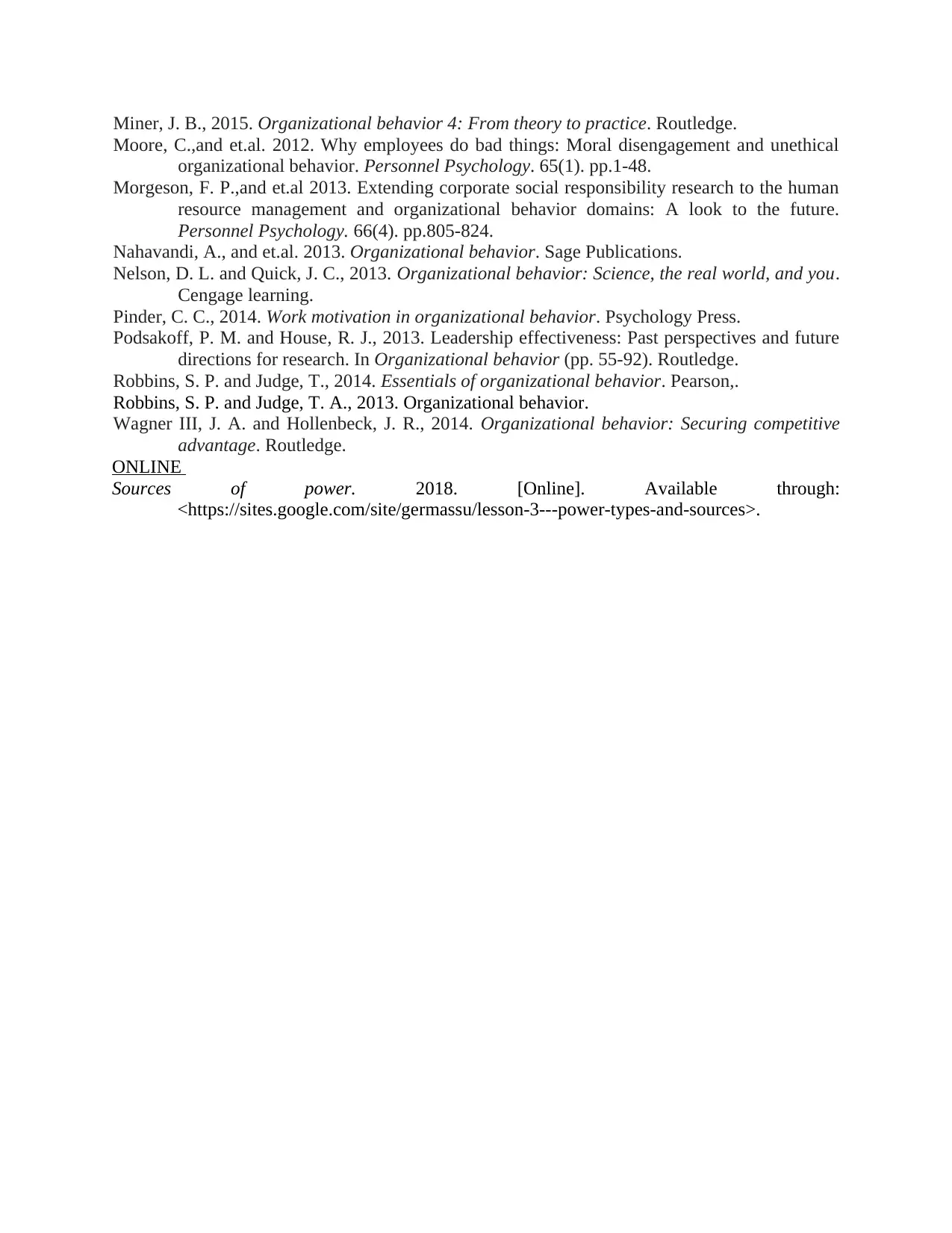
Miner, J. B., 2015. Organizational behavior 4: From theory to practice. Routledge.
Moore, C.,and et.al. 2012. Why employees do bad things: Moral disengagement and unethical
organizational behavior. Personnel Psychology. 65(1). pp.1-48.
Morgeson, F. P.,and et.al 2013. Extending corporate social responsibility research to the human
resource management and organizational behavior domains: A look to the future.
Personnel Psychology. 66(4). pp.805-824.
Nahavandi, A., and et.al. 2013. Organizational behavior. Sage Publications.
Nelson, D. L. and Quick, J. C., 2013. Organizational behavior: Science, the real world, and you.
Cengage learning.
Pinder, C. C., 2014. Work motivation in organizational behavior. Psychology Press.
Podsakoff, P. M. and House, R. J., 2013. Leadership effectiveness: Past perspectives and future
directions for research. In Organizational behavior (pp. 55-92). Routledge.
Robbins, S. P. and Judge, T., 2014. Essentials of organizational behavior. Pearson,.
Robbins, S. P. and Judge, T. A., 2013. Organizational behavior.
Wagner III, J. A. and Hollenbeck, J. R., 2014. Organizational behavior: Securing competitive
advantage. Routledge.
ONLINE
Sources of power. 2018. [Online]. Available through:
<https://sites.google.com/site/germassu/lesson-3---power-types-and-sources>.
Moore, C.,and et.al. 2012. Why employees do bad things: Moral disengagement and unethical
organizational behavior. Personnel Psychology. 65(1). pp.1-48.
Morgeson, F. P.,and et.al 2013. Extending corporate social responsibility research to the human
resource management and organizational behavior domains: A look to the future.
Personnel Psychology. 66(4). pp.805-824.
Nahavandi, A., and et.al. 2013. Organizational behavior. Sage Publications.
Nelson, D. L. and Quick, J. C., 2013. Organizational behavior: Science, the real world, and you.
Cengage learning.
Pinder, C. C., 2014. Work motivation in organizational behavior. Psychology Press.
Podsakoff, P. M. and House, R. J., 2013. Leadership effectiveness: Past perspectives and future
directions for research. In Organizational behavior (pp. 55-92). Routledge.
Robbins, S. P. and Judge, T., 2014. Essentials of organizational behavior. Pearson,.
Robbins, S. P. and Judge, T. A., 2013. Organizational behavior.
Wagner III, J. A. and Hollenbeck, J. R., 2014. Organizational behavior: Securing competitive
advantage. Routledge.
ONLINE
Sources of power. 2018. [Online]. Available through:
<https://sites.google.com/site/germassu/lesson-3---power-types-and-sources>.
1 out of 18
Related Documents
Your All-in-One AI-Powered Toolkit for Academic Success.
+13062052269
info@desklib.com
Available 24*7 on WhatsApp / Email
![[object Object]](/_next/static/media/star-bottom.7253800d.svg)
Unlock your academic potential
© 2024 | Zucol Services PVT LTD | All rights reserved.





